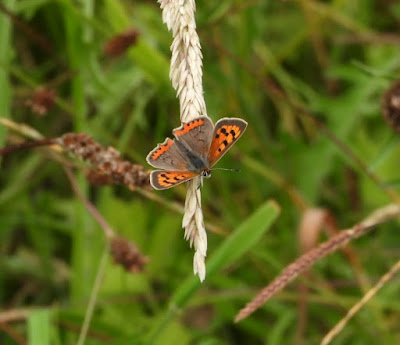As far as I'm concerned, it's definitely a good year for butterflies.
I've had my eye on the developing nature reserve at Chopwell East Field. Over the winter I noticed it was being grazed by highland cattle and wondered what the results would be this summer. I eventually revisited last Tuesday to find another abundant supply of butterflies.
In the more Southern area the initial accent was actually on moths as around seven five-spot (I think) burnet moths were found nectaring on knapweed, with a similar number of shaded broad bars showing up as well.
 | | Five-spot Burnet |
|  | | Shaded Broadbar |
|
Again the dominant species in terms of numbers were meadow brown (some already very worn) and small skipper but also seen were large white, green-veined white, comma. small copper, and small tortoiseshell.
 | | Comma |
|  | | Green-veined White |
|
 | | Meadow Brown (worn) |
|  | | Small Copper |
|
 | | Small Skipper |
|  | | Small Tortoiseshell |
|
I took a little detour into a promising field the other path and noted similar activity. But on the way back I stopped to photo what I suspected to be a white-tailed bumblebee when it was chased off by another small butterfly that turned out to be a white letter hairstreak.
 | | White-tailed Bumblebee |
|  |
White Letter Hairstreak |
|
This was a considerable surprise as I have never heard of a white letter hairstreak being reported there and I do not believe there are any elm trees. It is however clear that there have been more of them about this year.
To trump it all I achieved a longstanding ambition the day after when i managed to get a couple of distant snaps of purple hairstreaks in the oaks by one of the viaducts at Hamsterley Mill. Unfortunately they weren't in great condition.
 |
| Purple Hairstreak |
Meanwhile the first butterfly has been sighted on the buddleia in the front garden. It was a red admiral.






















